1950 Chilean Grand Prix
The first, the last and the only
Author
- Lorenzo Baer
Date
- July 9, 2024
Related articles
- 1934-'37 Rio GPs - Postcards from Gavea, by Mario Cesar de Freitas Levy/Leif Snellman/Antonio Carlos Barque de Lima
- 1949 Brazilian Temporada - Brazil's forgotten racing days, by Lorenzo Baer
Who?Juan Manuel Fangio, Alfredo Pian, José Froilan González What?Ferrari 166, Maserati 4CLT, Ferrari 166 Where?Pedro Valdivia When?1950 Chilean GP |
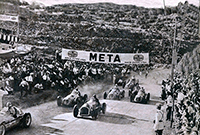 |
Why?
"Juan Manuel Fangio, taking the last curve, approaching the final straight, with a cheering the crowd in the stands, crosses the finish line first, taking the victory in the GP." This sentence was repeated so many times during the 1950s motorsport that it almost became a synonym for open-wheel racing during that decade. In addition to the 24 victories in official Formula GPs, countless other laurels decorated the driver's CV throughout his extensive racing career.
Although most of Fangio's historic victories were achieved in Europe, where the heart of motorsport resided in the 1950s, the driver still maintained a special connection with his South American roots. Not only through constant visits to his home country during the days of the Argentine GPs, but also because he was a fervent supporter of the development of Latin American motorsport. It was not uncommon to find Fangio during F1's pioneer years promoting some eccentric race in some exotic place in the Americas. His participation in the Argentine Formula Libre Temporadas during the 1950s is just one example of this, in addition to his participation in the Venezuelan GP, the Cuban GP, as well as some other races in Uruguay and Brazil.
However, one of Juan Manuel Fangio's most forgotten contributions to South American motorsport took place in Chile, in what is to this day the only official high-end single-seater race held in that country. The Grand Prix de la República de Chile may seem like just another one of those picturesque events in the history of single-seater races at the beginning of the fifties when this discipline was still embryonic compared of what it is today, but for Chileans, that race still has a special meaning: the country was, even if only for a few days, the stage for some of the names that would shine worldwide on the tracks in the following years.
The story behind the Chilean GP: South American motorsport in the 1950s
Latin America had gone through the terrible years of the Second World War almost unscathed, suffering for the most part only collateral damage resulting from the conflict. While Europe was rising from the ashes, the countries of the southern cone-shaped continent were experiencing an acute moment of economic growth, mainly due to a movement to strengthen South American states.
Regarding the automotive sector, South America now also emerged as a power, revealing drivers of equal, if not better, level than those produced in European countries. A new generation which would be known through names such as Fangio, Menditeguy, Froilán González, Cantoni and Landi would begin to demonstrate that talent on the race tracks would not only revolve around the United States-Europe axis: a new world emerged after the WW2, not only on a political or economic level, but also, on circuits around the world.
Such a process of development of LatAm's pilots began to develop during the war itself. While the UK, Germany, France and Italy prepared to exchange their light Formula Libres and voiturettes for heavy tanks and armoured vehicles, the American countries continued to promote racing as a form of public entertainment. In the US, such events lasted only until the country's entry into the conflict - that is, at the end of 1941; however, in the southern continent, such contests continued until 1943 when fuel rationing problems began to affect the frequency of such events.
The main havens for drivers were found in two countries: Brazil and Argentina. In the first, a profusion of races would be held between 1939 and 1943, with the main venues being in Rio de Janeiro (in the famous Circuito da Gávea), in addition to São Paulo (in both an incipient Interlagos, and Araraquara, which was a recurring point for races in the city). In the Argentine case, the locations were the most diverse: Buenos Aires (Costanera), Mendoza and Santa Fé, which hosted the major Argentine meetings. In addition to these, considered 'true GPs', countless other small voiturette races were contested intermittently in these countries, serving to add volume to the Latin American automobile calendar during the war years.
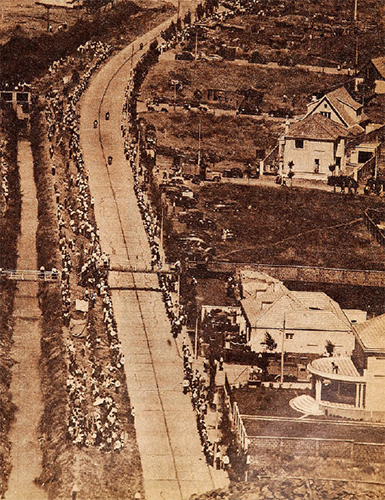
Photo of the main straight of the Pedro Valdivia circuit. The image was taken during one of the motorcycling races, which served as a warm-up for the GP event. (credits Revista Estadio)
When the war came to an end in 1945, and the activities of world motorsport resumed, European drivers were quick to notice how their South American counterparts had evolved in terms of quantity and quality. It's no surprise that from 1947 onwards, many of the world's top motorsports aces came to South America during the European winter months to compete against local drivers.
This was how drivers like Giuseppe Farina, Alberto Ascari and Luigi Villoresi had their first contact with names like Oscar Gálvez and Juan Manuel Fangio, in an exchange that was beneficial to all parties involved. For South American drivers, this was a unique opportunity to learn from those who were still considered the best in the world. On the other hand, for the South American nations that hosted these events, such races were a perfect chance to attract worldwide attention through the excellent publicity generated by a GP.
This generated a cycle that fed itself back and forth: these Grand Prix and Grandes Épreuves grew in importance, as increasingly 'heavier' names participated in these races. Such names raised the standards and importance of the event to a certain degree, which, consequently, grew in scale; something that would attract more big names for the next editions.
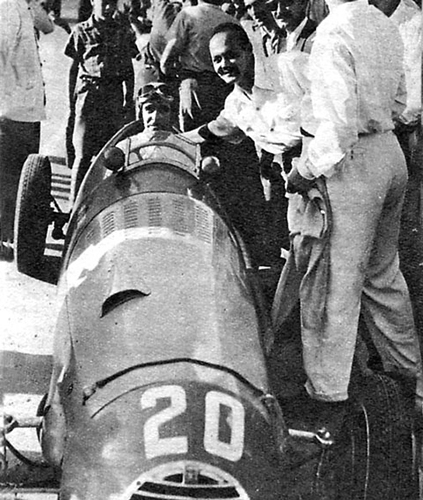
Bartolomé Ortiz was Chile's great hope in the race, driving one of the Simca-Gordini T15s loaned by the ACA. A fourth place in the final classification ended up being a good result for the driver in his national GP. (credits Revista Estadio)
However, there was a major flaw in the process of putting together the South American competition calendar, which even affected the talent generation process. In South America, almost a cartel had been established to promote GPs, involving Brazil, Uruguay and Argentina, and which basically monopolised these events. Even though this was largely due to the economic preponderance of these countries compared to the rest of the South American bloc, the lack of a GP outside the great triad of Latin American powers was felt, especially at a time when the car was becoming a consumer good, a symbol that combined the 'needs' of a person with its own personality.
Because of this, during 1949, the project that aimed to promote, somewhere in Chile, a true Grand Prix began to be outlined. Although the coastal cities of Viña del Mar or Valparaíso seemed to be the obvious choices to host a GP, as they were places already well frequented by tourists (mainly due to the beaches and casinos that exist on those sites), the choice of the venue for the event fell on Santiago, the country's capital. Therefore, now was the time to make preparations for the first Gran Premio de Chile.
Seeking strong allies
The organisers' first major decision was a sensible move to seek a strong partner who could provide guidance and assistance in preparing the Grand Prix. Even though it had been founded in 1928, the Automóvil Club de Chile (ACC) had no experience in organising a major event while its sporting arm, the Autoclub Sportivo Italiano de Chile/Audax Italiano (ASIC), had only organised events on a regional scale within the country.
Surveying their South American neighbours, the Chileans found in the Automóvil Club Argentino (ACA) a valuable and important supporter, which quickly demonstrated its interest in helping to promote the race in the Chilean capital. This fitted perfectly into the ASIC's plans, as the Argentinians already enjoyed great prestige in the Grand Prix scene in the early 1950s. The popularity of the Argentine Formula Libre Temporadas, which attracted names such as Reg Parnell, Nino Farina, Philippe Étancelin and Louis Chiron, was the best business card that Argentinians could show.
Furthermore, the ACA had developed an effective system for organising races throughout Argentina, with drivers traveling from the north to the south (and vice-versa) of the country to compete in the races; This allowed teams to compete in races on consecutive weekends (an extremely complicated logistics in Argentina in the 1950s) with a level of professionalism similar to that seen on the major European events.
Therefore, a collaboration agreement was quickly signed between ASIC and ACA, foreseeing that the latter would be responsible for various technical and organisational aspects of the race, including the call for interested drivers. As they were affiliated with the ACA, both Juan Manuel Fangio (also known as 'Chueco' - in English, crooked - because of his crooked legs gathered with his football skills) and José Froilán González ('El Toro de los Pampas') were basically tasked with being the main Argentine representatives in the race.
Each would have at their disposal a Ferrari 166, a car theoretically built for Formula 2 specs, but which spent a good part of its life racing in Formula Libre races. Based on the chassis of another Scuderia single-seater, the 125 F1 model, the 166 F2 proved to be a machine worthy of the Maranello designers. Starting from the chassis, everything had been remodeled to the new vehicle: the 1497cc V12 engine of the 125 F1 had been replaced by a 1995cc one; the vehicle's height from the ground had been reduced, ensuring greater stability; and by 1950, the 166 F2 had gained a De Dion axle, which had replaced the old torsion bar.
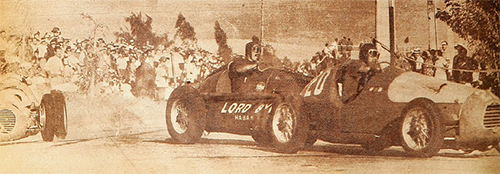
Chilean Bartolomé Ortiz (Simca-Gordini T15) manages to overtake Alberto Crespo (Plymouth 'Fuerza Limitada'), in one of the corners of Pedro Valdivia's circuit. (credits Revista Estadio)
The car selected for Froilán González, owned by the ACA official team, had been purchased in June 1949. Originally intended for Italian Bruno Sterzi, the car with chassis number 011F had been the result of a complicated negotiation between the Italian driver, the Scuderia Ferrari and the ACA itself. After trying to buy a second-hand Ferrari in March 1949, the Argentinians contacted the Italian manufacturer directly to see the possibility of purchasing a pair of new vehicles from the factory as soon as possible. After a brief conversation, the porteña team signalled positively with an Italian proposal to sell two 166 F2s to the ACA.
In parallel, however, Ferrari had also negotiated one of the vehicles with Sterzi who, on the other side of the coin, was looking to replace his own personal 166 SC with a car more suitable for F. Libre races. Therefore, for a short period of time, the same car had two owners, with an ocean separating them both.
When the Argentine delegation, made up of the president of the ACA, Francisco Borgonovo, the association's sporting director, Carlos Anesi, as well as Fangio himself, finally went to collect their order in Italy, they were shocked to see one of the Ferraris they had purchased was painted red (since the official colours of ACA cars were blue and yellow). The delegation was even more shocked after learning that the car had raced at the IV Circuit des Remparts, in the French region of Nouvelle Aquitaine, a few days earlier, with Sterzi in the wheel.
Negotiations between the parties dragged on until the II Gran Premio dell'Autodromo di Monza for Formula 2 cars, which would be held at the end of June. To put an end to the discussion of who was the real owner of the car, the ACA made an irrefutable proposal to Ferrari, which finally gave the Argentinians ownership of the machine, and as a final curiosity in this story it was Fangio, in the 011F, who ended up winning the Monza race!
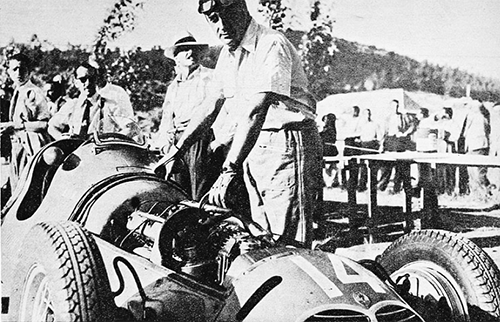
Despite appearing strong at the start, Louis Rosier ended up disappointing in the race. An engine problem on lap 6 decreed the end of the driver's ambitions in the GP. (credits unknown)
The story of the second ACA vehicle was more common, so to speak: the car was delivered without problems to the Argentinians, at the end of 1949. This vehicle, number 013F, was significantly different from the 011F, due to modifications made by the Scuderia that provided for greater rigidity in the chassis which, it was assumed, would guarantee greater reliability in longer races. Both cars (the 011F and 013F) went through a series of tough tests during the 1949/50 Argentine Temporada, in the hands of Benedicto Campos and J.M. Fangio.
In addition to Fangio and González (who had taken the place of Campos in the ACA team after the end of the 1949/50 Temporada), two other drivers would join the roster of the Automóvil Club Argentino squad for this race: Chilean Ismael González who, due to the agreement between the ACA and the ASIC, had managed to get a place on the Argentine team, and the experienced Frenchman Louis Rosier, who ended up being the only European present in the race – something that went down as being the biggest disappointment in the organisation of the race, which failed to attract any other 'foreigners'. Both Ismael and Rosier would race with old Maserati 4CLTs provided by ACA.
Even with the absence of other European drivers, the final list of the race still had some good names: Argentinians Onofre Marimón and Carlos Menditeguy, who would be recurring names in F1 in the coming years, accepted the invitation to participate in the race, each having a Maserati. The peculiarity would be that these drivers would not race alone in the race, participating in pairs that would take turns driving the cars.

A duel of Maseratis: Eitel Cantoni fends off an attack by Pascual Puopulo in a very Latin American confrontation.
(credits unknown)
In Marimón's case, his driving partner would be another Argentinian, Pascual Puopolo, with both sharing a Maserati 4CLT. Carlos Menditeguy, on the other hand, had a 4CL at his disposal, an older version of the Italian manufacturer's vehicle, which he would take turns with Bolivian León Suarez. Other members of the Argentine armada that left for Chile were Alfredo Pian (Maserati 4CLT), Alberto Crespo (Plymouth 'Fuerza Limitada') and Jose López (Chevrolet 'Special' Mecanica Nacional).
Another reasonably well-known name from the 1950s who would participate in the race in Santiago was Eitel Cantoni, who, despite being Uruguayan, would become one of the most important figures in Brazilian motorsport, after his co-participation (along with Chico Landi), in the formation process and structuring of Escuderia Bandeirantes, with which he would even compete in some races in the F1/F2 World Championship of 1952.
On the other hand, of the lesser-known names on the grid, there were two other Chileans: Bartolomé Ortiz Sanz (an experienced and well-known motorcycle racer in his homeland) and Ismael Lopez, both racing with Simca-Gordini T15 cars, leased by the ACA – even though both were not part of the Argentine official team. Therefore, twelve cars and 14 drivers were prepared to challenge the narrow streets of the city located at the foothills of the Andes.
Santiago, Santiago
When the drivers arrived at the scene, they were fascinated by the track, which even though was small by 1950s' standards, at just 2250m length, was extremely fast – especially considering that this would be a street race. The route ran through the streets of the Pedro Valdivia Norte neighbourhood, a small strip of land located between the San Cristóbal hill and the Mapocho river, in the central region of the Chilean capital.
The triangle-shaped layout was formed by the Avenues of Santa María (where the track's start/finish straight was located) and El Cerro; an avenue with a long-left radius bend, which formed the last two remaining sides of the triangle. The El Cerro Avenue was also split in two, by a left/right chicane. At this point was the most technical part of the track, as the cars came at great speed to try to negotiate with this treacherous little sequence of curves.

The only known photo of the start of the 1950 Chilean Grand Prix. J.M. Fangio jumped ahead, followed by Pian and Gonzalez. (credits Revista Estadio)
In the practice sessions, Juan Manuel Fangio proved to be the fastest, securing top position on the starting grid. Next to him on the grid was Alfredo Pian who with his Maserati had overshadowed the other big favourite of the race, Froilán González – the other Ferrari driver would start in third place. Diving into the rest of the grid, we had in order: Rosier and Puopolo, on the third row; on the fourth, Uruguayan Cantoni; on the fifth row, Crespo and Ortiz; on the sixth, the solitary Suarez; and finally, on the seventh, Ismael Gonzalez and José Lopez.
After the final adjustments to the machines, the day of the race finally arrived, which was now known as the Gran Premio del Presidente Alessandri, in honor of the former Chilean president Arturo Alessandri, who had been a pivotal figure in the country's politics in previous decades and had passed away, just a few months earlier. After a series of support races for touring cars and motorcycles, it was the Formula Libre's turn to shine, for 60 laps, on the streets of the Chilean capital.
The start signal was given at 18:00 pm and Fangio jumped into the lead, followed by Froilán González, who took advantage of the greater power of his Ferrari to overtake Pian before the first corner. Louis Rosier also had a good start, demonstrating that not only the quality of the car mattered in these situations. The Frenchman went into attack mode as soon as the flag was waved, knowing that only a bold performance could take him close to the superior Ferraris.
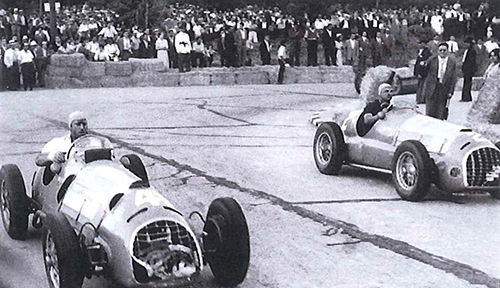
J.M. Fangio goes wide in the curve, and Froilán González take the oportunity to slip in. (credits unknown)
On the second lap, Rosier was already following Fangio and Froilán González, with the trio opening up an advantage over the rest of the field. Fangio was the fastest of the three, setting the circuit's absolute record on this same lap: 1.01.2, with an average speed of 113.764kph. Who seemed to be the best Chilean in the race so far was Bartolomé Ortiz who, after disputes with Eitel Cantoni and Pascual Puopolo (who would do the first stint in the Maserati 4CLT #4), had moved up a few positions in the general classification.
Returning to the top spots, Fangio and González continued to duel intensely, with Rosier just lurking behind the main ACA duo. But on lap 6, a casualty occurred in the fight for the lead: the Frenchman's Maserati engine couldn't resist the strong pace imposed by its opponents, forcing Rosier to take a long stop in the pits to cool his engine. Right behind, another misfortune, when three laps later, Bartolomé Ortiz had problems with the gear lever and was also forced to take a tour of the pit area.
In the following laps, the crowd's attention was completely focused on the duel between teammates Fangio and González. The friendship that existed between the pair disappeared on the track, with each driver taking advantage of every gap left by their rival; the lead was constantly alternating, with 'Chueco' leading on some laps and 'El Toro de los Pampas' leading on others.
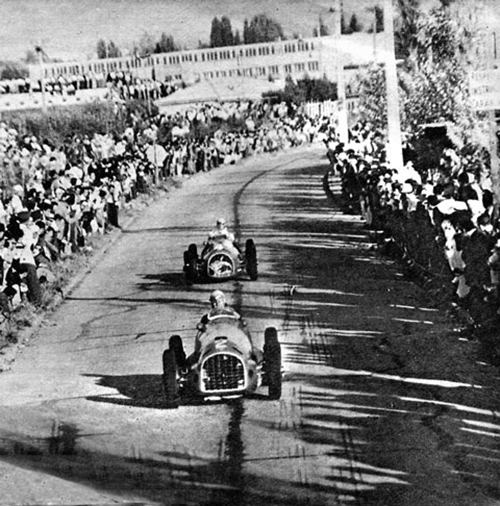
The duo of González and Fangio had no problem holding onto the lead, with a constant relay serving to distance the Argentinians from the rest of the field. In the photo, it is 'El Toro de los Pampas' who appears at the front. (credits Revista Estadio)
With a quarter of the race already completed, the pair began to face the challenge of overtaking the backmarkers. While some gave space without problems, others proved to be tough obstacles for the drivers – such as the case of Cantoni, who, on lap 18, while trying to avoid an accident with one of the other cars, collided with Fangio, who was trying to complete the same move. Fortunately for the Argentinian, the Ferrari came out unscathed from the impact, with the biggest damage being some scratches on the blue and yellow finish of his car.
The following laps were marked by a series of retirements from drivers in the midfield: on lap 20, Alfredo Pian, who had done so well in the qualifying session, would abandon the race due to mechanical problems. On the 23rd, it was Ismael Gonzalez's turn to retire, due to a failure in the Maserati 4CLT's steering column. And finally, on lap 27, it was the Suarez-Mediteguy duo that said goodbye to the race.
As the laps faded away from the total tally, the battle for the lead increased in intensity again, as Fangio closed in on González. The distance between them was progressively reduced until the driver of Ferrari no.4 made his final attack on his teammate. Froilán González was unable to answer the blow and was resigned for the rest of the race to remain behind his compatriot.

The damaged front end of Fangio's Ferrari after his collision with Cantoni. (credits Revista Estadio)
When it appeared that this would be an exemplary race from an organisational and competitive point of view, disaster struck, as on the penultimate lap of the race, José Félix López, who was in sixth position, lost control at the chicane on the El Cerro straight, heading towards the crowd on the side of the track. At the last moment, the drive managed to change the direction of the vehicle, putting the car on a collision course with a pole and not with the crowd.
The driver's Chevrolet 'Special' burst into flames just seconds after López managed to get out of the car. Despite the fact that a much worse catastrophe had been avoided, the accident cost the life of a girl who was at the scene, a stain from which the event would never recover. José Félix López emerged with only slight bruises from the crash, and it was later discovered that the Argentine driver was not to blame, as a subsequent examination found that the vehicle's steering column cracked, which had affected the driver's ability to make the tight turn.
But with the event so close to its end, the race continued until the chequered flag. Juan Manuel Fangio crossed the finish line first, completing the 60 laps in 1.14.58.2, six tenths ahead of second-placed Froilán González. The domination of the Ferrari 166 F2 had been complete in the race, as third-placed Uruguayan Cantoni was two laps down on the ACA duo. The best home driver in the race was Bartolomé Ortiz who after overcoming the mechanical problem that had delayed him at the start of the race made a recovery run, taking advantage of his opponents' problems to finish in fourth position.
The aftermath
The 1950 Chilean GP was important in demonstrating that through alliances with other more traditional institutions it was possible to organise single-seater races in peripheral countries in world motorsport. Backed by the know-how of the Automóvil Club Argentino, the Autoclub Sportivo Italiano de Chile/Audax Italiano managed to promote a minimally organised event along the lines of those attended by the great drivers of the time.
The main problem laid in the money and sponsorship factor. This issue, which was generally the main cause for short-term and long-term failure in promoting GPs (until this day), was what victimised the sustainability of the Chilean GP for any future edition. If in Brazil, Argentina or Uruguay there were at least a couple sponsors always interested in organizing GPs which attracted an increasingly larger and more qualified contingent of drivers, Chile lacked this part of the equation.
Furthermore, although the Automóvil Club de Chile and the Autoclub Sportivo Italiano de Chile/Audax Italiano had gained valuable experience in the 1950 race, they were still far removed from the prestige enjoyed by the ACA and the ACB (Automóvel Clube do Brasil). Both the Argentinians and the Brazilians had knowledge of the organisation of international races that dated back to the 1920s and therefore were well ahead in this agenda to define interests and objectives when hosting events.
The questions above serve in part to explain not only why Chile but other South American countries such as Bolivia, Ecuador and Peru have never tried to promote a GP in their countries. On the other hand, countries like Venezuela which hosted its GP on an international scale between 1955 and 1957, and Colombia which had its only national GP in 1971, had their brief but ephemeral appearance on the world stage, contributing to give a small Latin American touch to the world motorsport.
Acknowledgements
- Chilean Newspaper El Mercurio (Santiago): edition of 18th December 1950
- Chilean Newspaper Las Ultimas Noticias: edition of 18th December 1950
- Chilean Magazine Estadio: edition of December 1950
- UTaC Team
